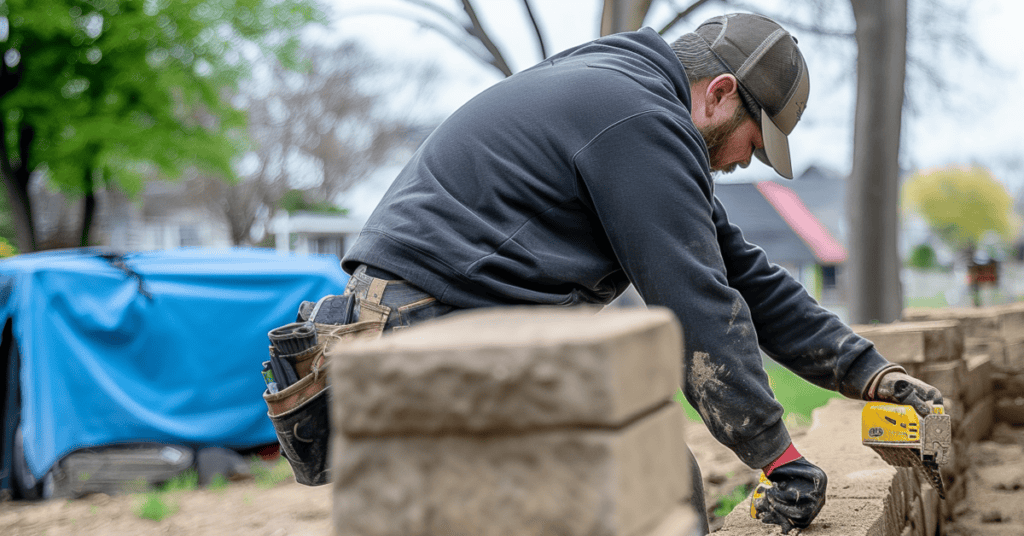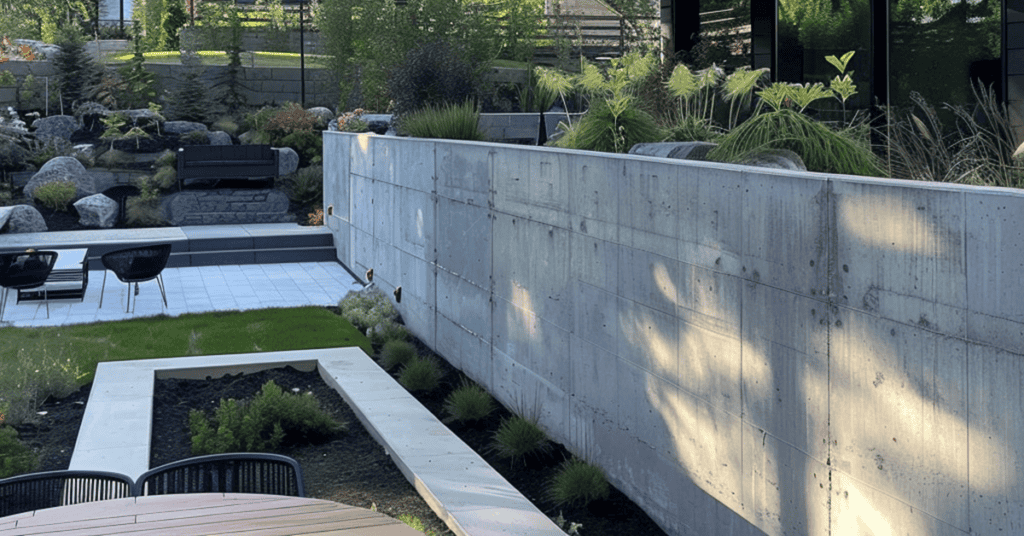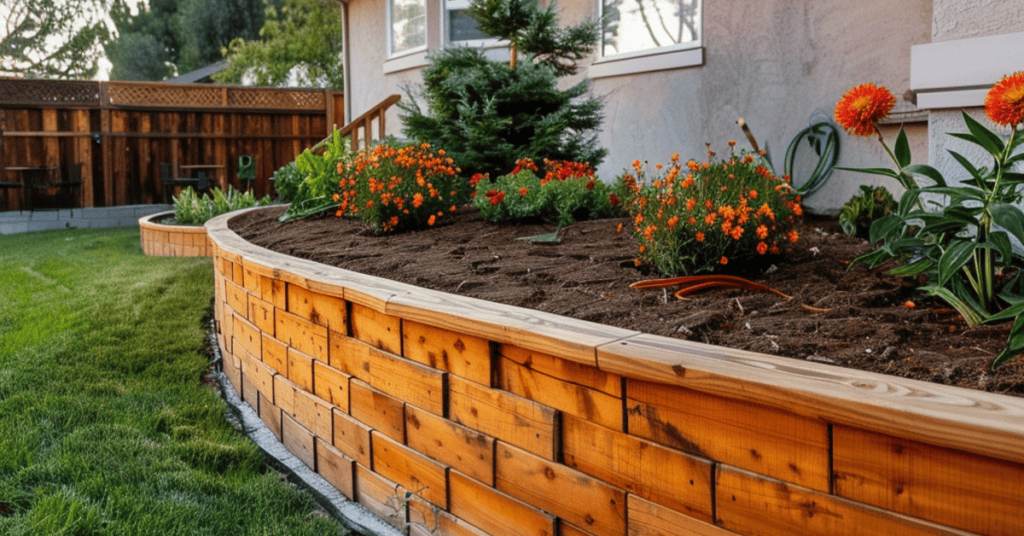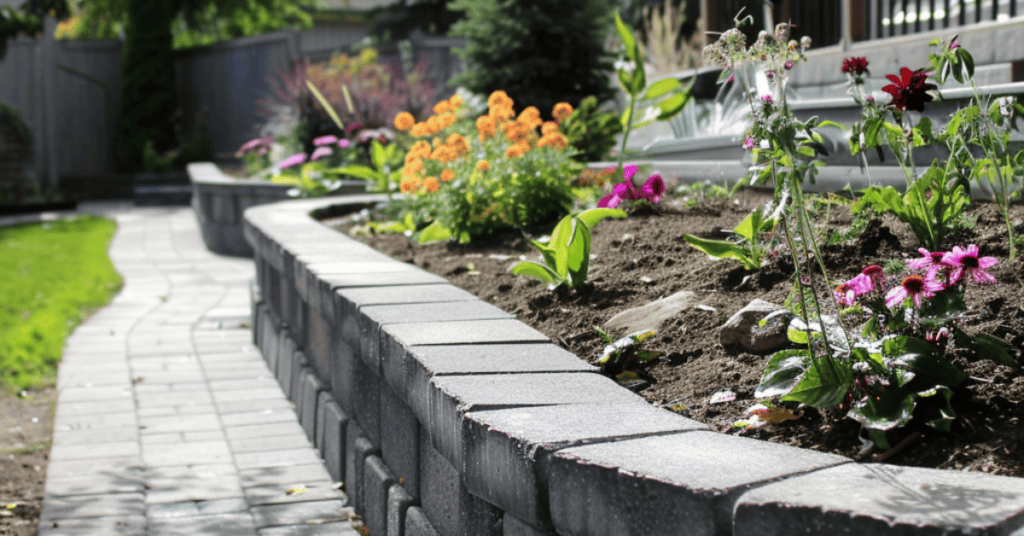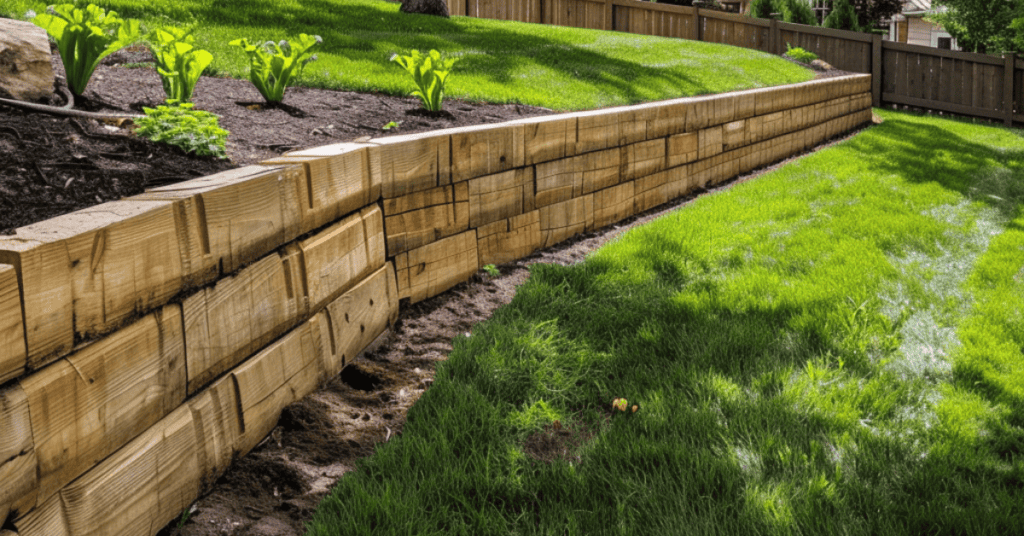Overview of Residential Retaining Walls
Retaining walls hold back soil and create stable, level areas in sloped landscapes. They prevent soil erosion by keeping the ground in place. By adding retaining walls, you can make your yard more usable and attractive.
Retaining walls also manage water drainage. When installed correctly, they direct water away from areas where water can do damage. Use them to create terracing, adding layers to your outdoor space.
A common use of retaining walls is to add landscaping features. You can place plant beds in areas that are reclaimed from your yard for planting areas. With the additional space that is recaptured, you can install outdoor entertaining features like patios and outdoor kitchens.
Retaining Wall Material Analysis
Note: The three main types of materials used for retaining walls are stone, wood and concrete blocks. The purpose of this article is to break down the pros and cons of both stone and wood – but we would be negligent if we didn’t at least touch on concrete block retaining walls. A concrete block retaining wall – like allan block retaining walls – offer amazing durability, a variety of colors, and interlocking blocks. They tend to be easier to build, last much longer than wood, and even stone in most cases. They can also withstand higher loads than wood and stone, making them the most versatile option.
Characteristics of Wood
The Good…
Wood retaining walls are easy to install and perfect for a DIY project. They usually use timber or wooden planks, which are affordable and available at most home centers. You can create strong walls by stacking and fastening wood pieces with weather resistant screws.
Wood adds beauty and can blend naturally into landscapes, providing a rustic look. It’s best for shorter walls that don’t hold too much weight.
The Not So Good…
Now the big drawbacks with building a timber wall. As an organic material, wood is prone to disintegrating over time due to the effects of sun, moisture, and pests. UV Rays can not only fade the appearance of wood retaining walls, it can also cause cracking and warping. Warm and cold cycles can cause the wood to expand and contract. This can result in splintering and cracking of the wood. Moisture can cause wooden retaining walls to rot – this is even more prevalent if the wood is located underground. Especially when moisture is a problem, insects like termites can also break down the wood.
To combat this, you’ll want to make sure that you use pressure treated wood that is more resistant to weather. You’ll also want to be diligent in performing maintenance tasks for wood retaining walls. Regular sealing and inspection can help you to improve the lifespan of wood walls. They usually last anywhere from 10 – 20 years depending on the climate, soil conditions, and your commitment to proper upkeep of your retaining wall.
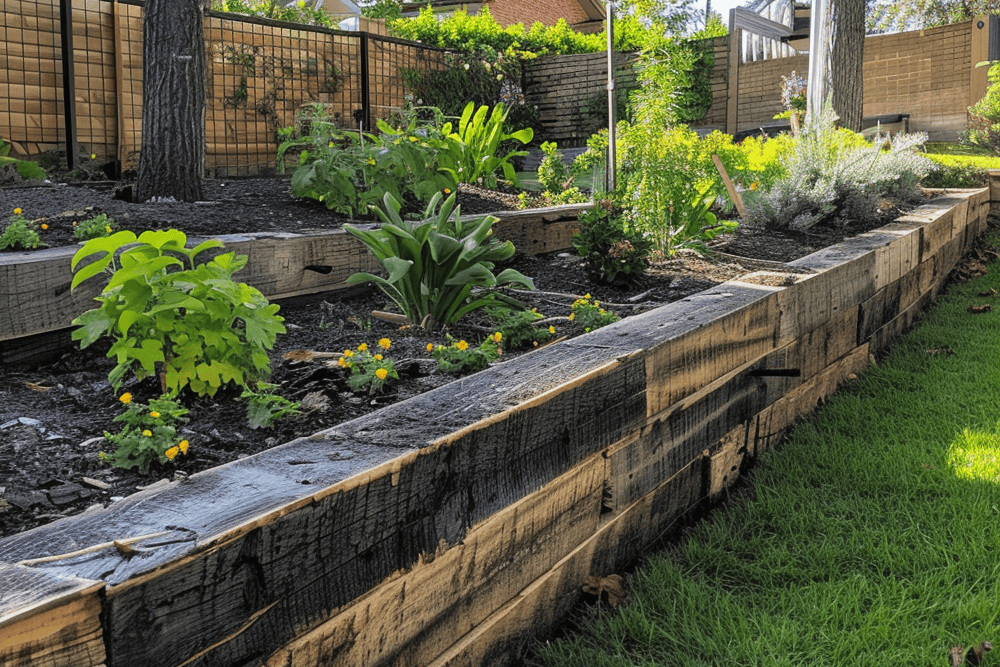
Wood Retaining Walls Provide a Natural Look – But They Require Quite a Bit of Upkeep
Characteristics of Stone
Stone retaining walls offer durability and a classic appearance. They can withstand significant weight and are suitable for varied climates. The stones can come in different sizes and shapes, allowing for a customized look. Split stones are often used, which come in 8-12 inch widths, making them versatile for different designs.
These walls need a solid base. You should compact gravel behind the wall to prevent voids. This adds to their stability and longevity.
Stone walls require less maintenance compared to wood. They are much more resistant to rot and pests. Stone walls still do face issues like cracks and weathering. You’ll have to inspect the wall regularly for signs of cracking. Small cracks lead to bigger problems if ignored. Fill in cracks promptly with mortar.
Weathering can weaken the structural integrity of stone walls over time. Applying a sealant or a water repellent to the stone can help protect against weathering.
Besides the occasional cleaning and maintenance activities, these walls can last for decades, offering a long-term landscape solution.
Building a Natural Stone Wall is Similar to Building a 3D Jigsaw Puzzle with Very Heavy Pieces
Design Considerations
Both wood and stone retaining walls offer distinct design benefits. Your decision will depend on factors like appearance and structural requirements. These considerations are mostly dependent on personal preferences.
The appearance of your retaining wall plays a big role in your landscape. Wood and stone have different styles and textures. Wood gives a natural look that can blend well with various settings. It often comes in colors like browns and tans, lending warmth to your design.
Stone walls offer a range of shapes and textures. You can choose from cut stone or rough, natural pieces. Stones come in many colors, from gray to warm earth tones. Stone adds a timeless, sturdy look to your property. Each option has unique aesthetic appeal; the right choice depends on your landscape style.
Technical Comparison
Comparing wood and stone retaining walls involves understanding their capacities, attributes, and maintenance needs.
Height and Pressure Capacities: Advantage Stone
Wood retaining walls generally support shorter heights, up to 4 feet. They struggle with higher pressure and weight. The post-and-beam structure helps but limits their use for taller constructions. Pressure-treated lumber can resist ground pressure, but it’s not as strong as other materials.
Stone retaining walls, on the other hand, can reach greater heights. They handle more pressure due to their solid construction. You can stack stones to allow walls that can support higher loads. Stone’s natural strength makes it ideal for projects where wood wouldn’t be a good fit.
Weight and Strength Attributes: Advantage Stone
Wood retaining walls are relatively light. This makes them easy to install, especially for DIY projects. Weight can impact the wall’s stability, especially under high pressure. Ensure proper anchoring with T-shaped timber deadmen and a crushed stone footing for added support.
A stone retaining wall is heavier and offers more strength. The weight helps with stability, reducing the need for additional support. The interlocking nature of stone or concrete blocks improves the wall’s ability to bear loads. This strength means less maintenance in the long run.
Drainage and Durability: Advantage Stone
Proper drainage is crucial for wood retaining walls to prevent rot. Pressure-treated lumber resists moisture, but you should install a drainage system behind the wall. This prevents water buildup and extends the wall’s life. Regular maintenance can help address any issues promptly.
Stone walls excel in durability. They are less affected by water, as interlocking stones allow water to drain naturally. This inherent drainage improves the wall’s lifespan. Mortar can add to the durability, though stone alone is often sufficient. Minimal maintenance is required, making stone a long-lasting option.
Lifetime Retaining Wall Cost: Advantage Stone
Costs of Wood
Wood walls often use timber or railroad ties. These materials suit simple, smaller walls. Timber walls cost anywhere from $15 – $30 per square face foot, making them more budget-friendly for the initial build for many projects.
From a maintenance standpoint, wood doesn’t do nearly as well. A wood wall will have to be replaced within 20 years – and will likely need frequent costly repairs before the end of the retaining wall’s life. There is also the frequent – sometimes annual – sealing and staining of a wood wall which takes time and materials and adds to the lifetime cost of the wall.
Costs of Stone
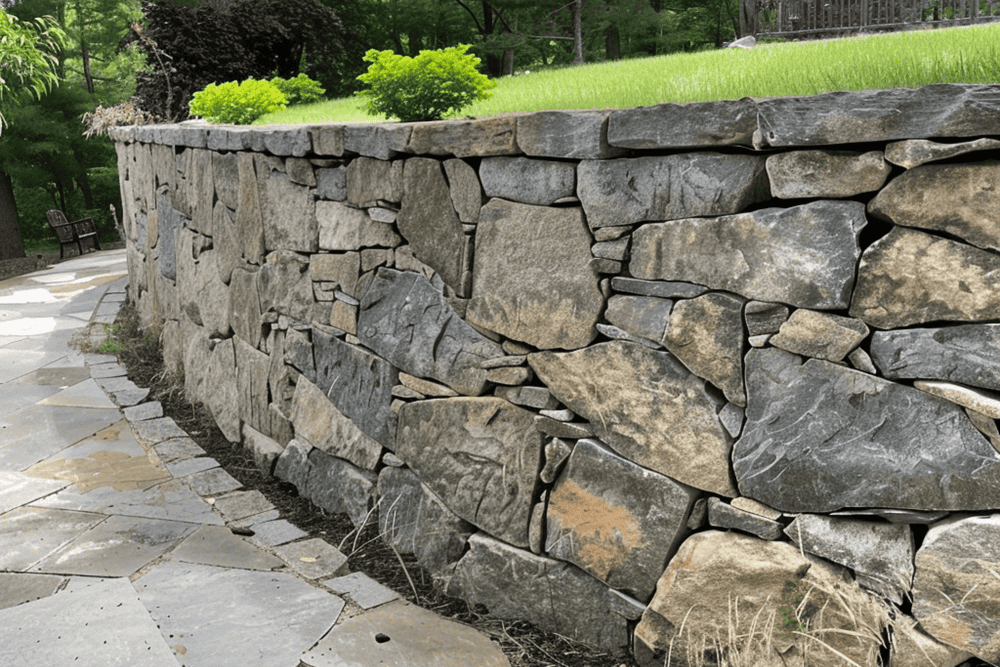
Over the Life of the Retaining Wall, Stone’s Durability Provides it with a Lower Lifetime Cost than Wood
Natural stone walls can be more complex. They require a strong base and precise stacking. Costs can reach up to $25 per square face foot for natural stone. In most cases, stone will be significantly more expensive than a timber retaining wall.
The good news is that stone walls require less much maintenance than wood walls. They don’t wear down nearly as quickly as wood walls and won’t have to be replaced as quickly as their wood retaining wall counterparts. Maintenance is also relatively easy – with periodic inspections required, but no sealing, staining and minimal repairs when compared to wood walls.
Note: for comparison purposes, the cost of materials for a concrete block wall generally falls between the costs of wood and natural stone. Building costs for a concrete retaining wall will generally be less than the initial construction cost of a natural stone wall – but lifetime costs can vary.
Frequently Asked Questions
Wood and stone retaining walls offer different benefits. Costs, longevity, design, and materials all play crucial roles in your decision.
What are the pros and cons of wood versus stone retaining walls?
Wood retaining walls are easier to install and affordable. They can fit well into natural landscapes. However, they may require more maintenance and can rot over time.
Stone retaining walls are durable and offer a timeless look. They resist weathering and need less upkeep. They are often more expensive and harder to install due to their weight.
How does the cost comparison between wood and stone retaining walls impact the selection process?
Wood retaining walls usually cost less upfront. They may need more frequent repairs or replacements. Stone walls have higher initial costs. They last longer and require less maintenance, which can save money over time.
What is the expected longevity of a wooden retaining wall compared to that of a stone retaining wall?
A well-constructed wood retaining wall lasts about 20 years. It can vary based on environmental factors and maintenance.
Stone retaining walls can last more than 100 years. They are more resistant to weather and pests, ensuring a longer lifespan.
When choosing materials for a retaining wall, what are the primary considerations to bear in mind?
Consider the landscape and climate. Wood retains moisture, which may lead to rot in damp areas. Stone resists moisture better but can be more expensive and labor-intensive. Also, think about the desired aesthetic and overall durability.
What innovative design ideas can be implemented with wood retaining walls?
Incorporate planters or benches into your wood retaining wall. You can also use different stain colors to create patterns. Mixing different types of wood provides a unique look.
How do engineered wood retaining walls stack up against traditional stone blocks in terms of durability and maintenance?
Engineered wood offers better resistance to rot and insects than natural wood. It may still require more upkeep than stone, such as periodic staining or sealing. Stone blocks offer unmatched longevity with minimal maintenance, making them a sturdy and reliable option.

